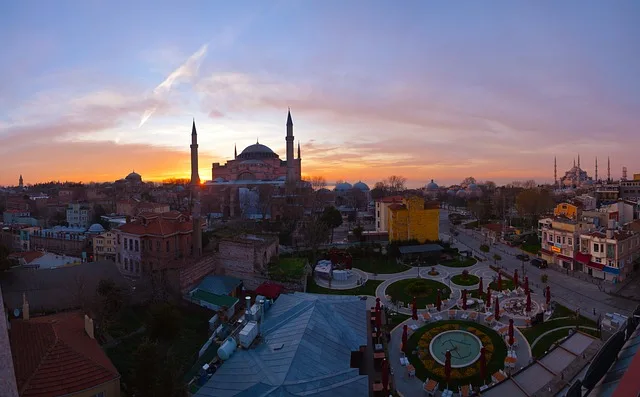Isn’t it fascinating how a single building can embody such diverse narratives? The soaring domes and intricate mosaics tell stories of devotion, artistry, and cultural exchange. When you gaze up at the vast dome, it feels like you’re staring into the heavens, a reminder of the spiritual aspirations that have inspired countless generations. The play of light filtering through the stained glass creates an ethereal atmosphere, inviting visitors to pause and reflect.
But the Hagia Sophia isn’t just about its breathtaking beauty; it’s a symbol of resilience. It has stood the test of time, weathering political upheavals and cultural shifts. Each stone, each arch, carries the weight of history, making it a powerful reminder of our shared human experience.
As you wander through its halls, you can almost hear the whispers of those who have come before—scholars, artists, and worshippers. It’s a place where faith transcends boundaries, inviting everyone to explore its rich tapestry of stories. Whether you’re a history buff, an art lover, or simply someone seeking a moment of peace, the Hagia Sophia Grand Mosque offers a unique glimpse into the heart of a city that has been a crossroads of civilizations for centuries.
Hagia Sophia: Bridging Cultures and Faiths Through Centuries of History
As you gaze up at the stunning mosaics, you can almost hear the echoes of Byzantine chants mingling with the calls to prayer that resonate through its vast halls. Isn’t it fascinating how a single space can embody such diverse beliefs? The transition from a cathedral to a mosque in 1453, and later to a museum, reflects the dynamic nature of faith and culture. It’s like watching a beautiful dance, where each step represents a different era, yet they all flow together seamlessly.
Hagia Sophia stands as a bridge, connecting not just two religions but also countless stories of people who have walked its floors. Picture the pilgrims, artists, and scholars who have sought inspiration within its walls. Each visitor leaves with a piece of its history, a reminder of how interconnected we all are, regardless of our backgrounds.
From Cathedral to Mosque: The Transformative Journey of Hagia Sophia
But then, in 1453, everything changed. The Ottomans swept in, and Hagia Sophia underwent a remarkable metamorphosis. It was no longer just a cathedral; it became a mosque, a symbol of Islamic faith and culture. Imagine the vibrant call to prayer replacing the choral echoes, the intricate Islamic calligraphy adorning the walls where once there were Christian icons. This shift wasn’t just a change of use; it was a profound transformation that reflected the dynamic history of a city at the crossroads of civilizations.

As you walk through Hagia Sophia today, you can almost feel the layers of history. The mingling of Christian and Islamic elements creates a unique tapestry that tells a story of coexistence and change. The stunning minarets rise alongside the original Byzantine architecture, a testament to the building’s ability to adapt and thrive through centuries of cultural shifts. Isn’t it fascinating how a single structure can embody such diverse narratives?
Hagia Sophia Grand Mosque: A Living Testament to Architectural Marvels
Picture this: built in the 6th century, the Hagia Sophia was originally a cathedral, a beacon of Byzantine architecture. Its massive dome, adorned with intricate mosaics, was revolutionary for its time. It’s as if the architects took a giant leap of faith, pushing the boundaries of what was possible. And then, in the 15th century, it transformed into a mosque, adding layers of beauty with minarets that reach for the sky, like fingers pointing towards the divine.

But what truly sets the Hagia Sophia apart is its ability to adapt and evolve. It’s a living testament to the resilience of human creativity. Each corner of this grand mosque whispers tales of the past, from the soft glow of the stained glass to the echo of prayers that have filled its halls for centuries. Can you feel the weight of history in the air? It’s palpable.
Faith and Heritage: Exploring the Spiritual Significance of Hagia Sophia
Hagia Sophia has been a church, a mosque, and now a museum, each phase adding to its spiritual tapestry. Can you feel the weight of history in its walls? The intricate mosaics and soaring domes tell stories of devotion and artistry that span over a millennium. For many, it’s a pilgrimage site, a place where the divine meets the earthly. The blend of Christian and Islamic elements creates a unique spiritual experience that resonates with visitors from all walks of life.
Think of it as a bridge between worlds—where East meets West, and faith intertwines with heritage. The light filtering through the stained glass casts a kaleidoscope of colors, almost like a divine spotlight illuminating the sacred. It’s no wonder that people leave Hagia Sophia feeling transformed, as if they’ve touched something greater than themselves.
Frequently Asked Questions
What role does Hagia Sophia play in contemporary religious practices?
Hagia Sophia serves as a significant site for contemporary religious practices, reflecting its dual heritage as a former cathedral and mosque. It is a symbol of cultural and religious convergence, attracting visitors and worshippers from various faiths. The site is used for Islamic prayers, while also being a place of historical interest for Christians and tourists, highlighting its ongoing relevance in interfaith dialogue and cultural identity.
How has the function of Hagia Sophia changed over time?
The structure has transitioned from a cathedral to a mosque, and now serves as a museum and cultural site. Originally built as a Christian basilica in the 6th century, it was converted into a mosque in the 15th century after the Ottoman conquest. In the 20th century, it was secularized and opened as a museum, showcasing its rich history and architectural significance. Recently, it has reverted to a mosque, reflecting ongoing cultural and religious dynamics.
What is the historical significance of Hagia Sophia Grand Mosque?
The Hagia Sophia Grand Mosque holds immense historical significance as a masterpiece of Byzantine architecture and a symbol of the cultural and religious transformations in Istanbul. Originally constructed as a cathedral in the 6th century, it was the world’s largest cathedral for nearly a thousand years. Following the Ottoman conquest in 1453, it was converted into a mosque, reflecting the city’s Islamic heritage. Today, it stands as a UNESCO World Heritage site, representing the intersection of Christianity and Islam, and showcasing the rich history of the region.
Can visitors access Hagia Sophia, and what are the visiting hours?
Visitors can access Hagia Sophia, which is open to the public. The visiting hours typically vary, so it’s advisable to check the official website for the most current information. Generally, it is open daily, allowing guests to explore its rich history and stunning architecture.
What architectural features make Hagia Sophia unique?
Hagia Sophia is renowned for its massive dome, which appears to float above the central nave, creating an awe-inspiring interior space. Its innovative use of pendentives allows for the transition from a square base to a circular dome. The building also features intricate mosaics, a harmonious blend of Christian and Islamic art, and a rich history reflected in its diverse architectural styles, including Byzantine and Ottoman influences.

